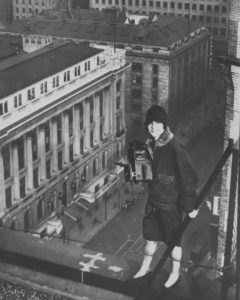Margaret Bourke-White
(1904-1971) Known for her extensive contributions to photojournalism, particularly for her Life magazine work, she began her career in Cleveland. The first female documentary photographer accredited by the U.S armed forces, she became one of the first four staff photographers for Life when it began publication in 1936. Her images of Montana’s Fort Peck Dam were featured on the cover and used in the feature story of the first issue. Throughout the 1930s Bourke-White was sent to create photo-essays in Germany and the Soviet Union as well as the Dust Bowl in the American Midwest: experiences that allowed her to refine the dramatic style she had used with industrial and architectural subjects, and introduced people and social issues as subject matter into her oeuvre, bringing a compassionate humanitarian approach to such photos.
From 1939 to 1942 she was married to Southern novelist Erskine Caldwell, with whom she collaborated on three illustrated books: You Have Seen Their Faces (1937), about Southern sharecroppers; North of the Danube (1939), about life in Czechoslovakia before the Nazi takeover; and Say, Is This the U.S.A. (1941), with writer Erskine Caldwell, about the industrialization of America. Working directly with the U.S. armed forces, she covered World War II for Life. While crossing the Atlantic to North Africa, her transport ship was torpedoed and sunk, but Bourke-White survived to cover the bitter daily struggle of the Allied infantrymen in the Italian campaign., then the siege of Moscow, which she wrote about in her book Shooting the Russian War (1942). Near the end of the war, she crossed the Rhine into Germany with Patton’s Third Army. Her photographs of the emaciated inmates of concentration and the corpses in gas chambers stunned the world.
